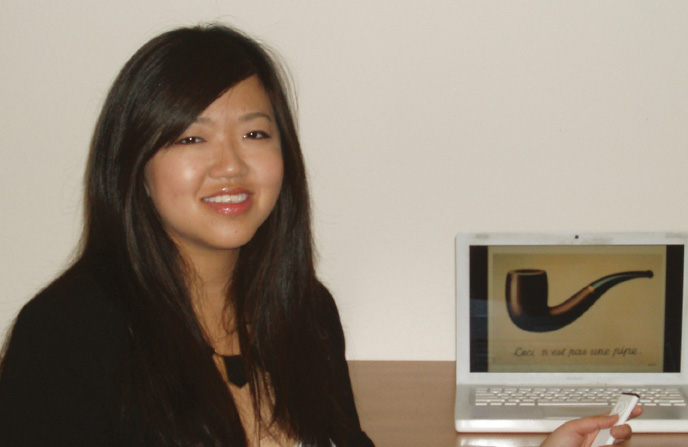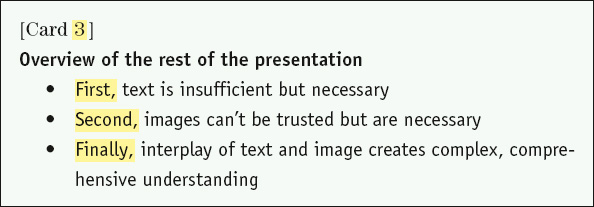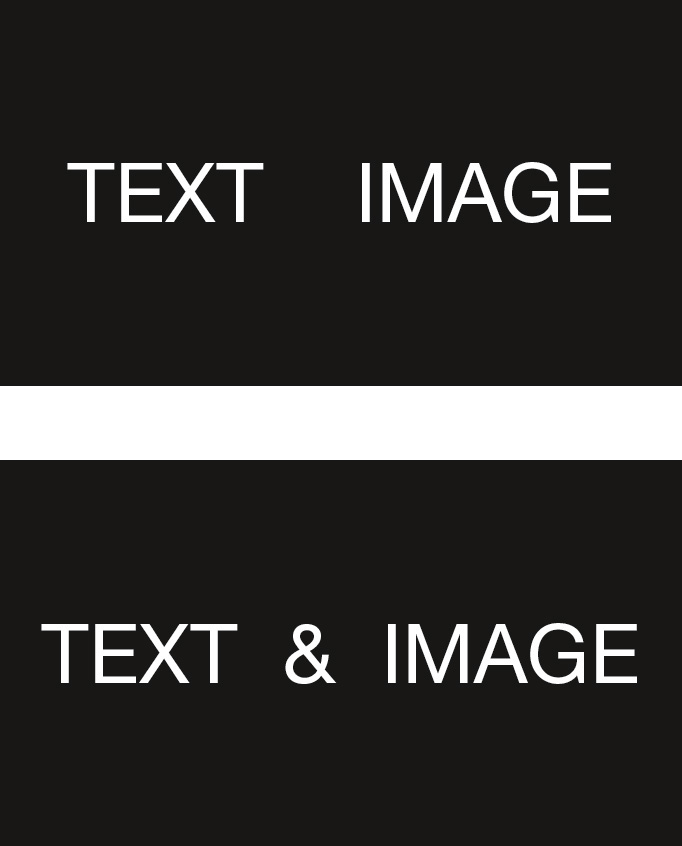3cPrepare for presentations.
More and more students report that formal presentations are becoming part of their work both in and out of class. Good preparation is as necessary for a successful presentation as for any other writing assignment.
Considering your assignment, purpose, and audience for presentations
Begin preparing for a presentation as soon as you get the assignment. Think about how much time you have to prepare; how long the presentation is to be; whether you will use written-out text or note cards; whether visual aids, handouts, or other materials are called for; and what equipment you will need. If you are making a group presentation, you will need time to divide duties and practice. Make sure that you understand the criteria for evaluation—how will the presentation be graded or assessed?
Consider the purpose of your presentation (5d). Are you to lead a discussion? teach a lesson? give a report? engage a group in an activity? Also consider the audience (5e). If your instructor is a member of the audience, what will he or she expect you to do—and do well? What do audience members know about your topic? What opinions do they already hold about it? What do they need to know to follow your presentation and perhaps accept your point of view?
For Shuqiao Song’s print essay, see 12e.
Student Shuqiao Song got a two-part assignment for her writing class on graphic novels: she had to write an argument essay based on her research on a graphic novel, and then she had to turn that information into a script for a twelve-minute oral presentation with slides. After brainstorming and talking with her instructor, she chose Alison Bechdel’s memoir Fun Home: A Family Tragicomic as her topic. She realized that although she wanted very much to earn a good grade, she also wanted to convince her classmates that Bechdel’s book was complex and important—and she wanted to turn in a truly impressive performance in her presentation.
Preparing for Presentations
AT A GLANCE
Preparing for Presentations
- How can you ensure that your text meets the expectations of a live audience?
- How does your presentation fulfill your purpose, including the goals of the assignment?
- How do the introduction and conclusion hold the audience’s attention?
- Is your organizational structure crystal clear? How do you guide listeners? Are your transitions and signpost language explicit? Do you effectively repeat key words or ideas?
- Have you marked the text you are using for pauses and emphasis?
- Have you prepared all necessary visuals, including presentation slides and other multimedia? Are they large enough to be seen? Would other visuals be helpful?
- Have you practiced your presentation and gotten responses to it?
Making your introduction and conclusion memorable
Listeners, like readers, tend to remember beginnings and endings most readily, so work extra hard to make these elements memorable. Consider, for example, using a startling statement, opinion, or question; a dramatic anecdote; a powerful quotation; or a vivid image. Shifting language, especially into a variety of language that your audience will identify with, is another effective way to catch their attention (see Chapter 22). Whenever you can link your subject to the experiences and interests of your audience, do so.
Shuqiao Song began her presentation this way:
Welcome, everyone. I’m Shuqiao Song and I’m here today to talk about residents of a dysFUNctional HOME. We meet these residents in a graphic memoir called Fun Home.
(Here, Shuqiao showed a three-second video clip of author Alison Bechdel saying, “I love words, and I love pictures. But especially, I love them together—in a mystical way that I can’t even explain.”)
Student Writing
That was Alison Bechdel, author of Fun Home. In that clip, she conveniently introduces the topics of my presentation today: Words. Pictures. And the mystical way they work together.
Note that this presentation opened with a play on words (“dysFUNctional HOME”) and with a short, vivid video clip that summed up the main topic of the presentation. Also note the use of short sentences and fragments, special effects that act like drumbeats to get and hold the attention of the audience.
Accessible Presentations
CONSIDERING DISABILITIES
Accessible Presentations
Do all you can to make your presentations accessible.
- Do not rely on color or visuals alone to get across information—some individuals may be unable to pick up such cues.
- If you use video, provide captions to explain any sounds that won’t be audible to some audience members.
Using explicit structure and signpost language
Organize your presentation clearly and carefully, and give an overview of the main points at the outset. (You may want to recall these points toward the end of the talk.) Then, throughout your presentation, call attention to a new point by pausing before it and by using signpost language as an explicit transition: The second crisis point in the breakup of the Soviet Union occurred shortly after the first is more explicit than Another thing went wrong. (For a list of transitions, see 8e.) Repeated key words and ideas work as signposts, too.
At the end of Shuqiao’s introduction, she set forth the structure of her presentation in a very clear, straightforward, and simple way to help her audience follow what came next:
Student Writing
So, let me outline the rest of my presentation. First, I’ll show how text is insufficient, but also why it is necessary in Bechdel’s story.
Second, I’ll show how images can’t be trusted yet why they are still necessary for Bechdel’s purpose.
Third and finally, I’ll show how the interplay of text and image in Fun Home creates a more complex and comprehensive understanding of the story.
Choosing words and sentence structures
Avoid long, complicated sentences, and use straightforward sentence structure (subject-verb-object) as much as possible. Listeners prefer action verbs and concrete nouns to abstractions. You may need to deal with abstract ideas, but try to provide concrete examples for them (23c).

Shuqiao Song’s presentation script included the following example:
Student Writing
Now, to argue my second point, I’ll begin with an image. This is a René Magritte painting. The text means, “This is not a pipe.” Is this some surrealist Jedi mind trick? Not really. Now listen to the title of the painting to grasp Magritte’s point. The painting is called The Treason of Images. Here Magritte is showing us that “this is not a pipe” because it is an image of a pipe.
Her short, straightforward sentences and vivid word choice (“Jedi mind trick”) help make this passage easy on listeners.
Turning writing into a script for presentation
Even though you will rely on some written material, you will need to adapt it for speech. Depending on the assignment, the audience, and your personal preferences, you may even speak from a full script. If so, double- or triple-space it, and use print that is large enough to read. Try to end each page with the end of a sentence so that you won’t have to pause while you turn a page. In addition, you may decide to mark spots where you want to pause and to highlight words you want to emphasize.
Take a look at this paragraph from Shuqiao Song’s formal written essay on Fun Home:
A PARAGRAPH FROM A WRITTEN ESSAY
Student Writing
Finally, we can see how image and text function together. On the one hand, image and text support each other in that each highlights the subtleties of the other; but on the other hand, the more interesting interaction comes when there is some degree of distance between what is written and what is depicted. In Fun Home, there is no one-to-one closure that mentally connects text and image. Rather, Bechdel pushes the boundaries of mental closure between image and text. If the words and pictures match exactly, making the same point, the story would read like a children’s book, and that would be too simple for what Bechdel is trying to accomplish. However, text and image can’t be so mismatched that meaning completely eludes the readers. Bechdel crafts her story deliberately, leaving just enough mental space for the reader to solve the rest of the puzzle and resolve the cognitive dissonance. The reader’s mental closure, which brings coherence to the text and images and draws together loose ends, allows for a more complex and sophisticated understanding of the story.
Now look at how she revised that paragraph into a script for oral presentation:
A PARAGRAPH REVISED FOR A LISTENING AUDIENCE
Student Writing
Finally, image and text can work together. They support each other: each highlights the subtleties of the other. But they are even more interesting when there’s a gap—some distance between the story the words tell and the story the pictures tell. In Fun Home, text and image are never perfectly correlated. After all, if the words and pictures matched up exactly, the story would read like a kids’ book. That would be way too simple for Bechdel’s purposes. But we wouldn’t want a complete disconnect between words and images either, since we wouldn’t be able to make sense of them.
Still, Bechdel certainly pushes the boundaries that would allow us to bring closure between image and text. So what’s the take-home point here? That in Bechdel’s Fun Home, image and text are not just supporting actors of each other. Instead, each offers a version of the story. It’s for us—the readers. We take these paired versions and weave them into a really rich understanding of the story.
Note that the revised paragraph presents the same information, but this time it is written to be heard, using helpful signpost language, some repetition, simple syntax, and informal varieties of English.
Speaking from notes
If you decide to speak from notes rather than from a full script, here are some tips for doing so effectively:
- In general, use one note card for each point in your presentation.
- Number the cards in case they get scrambled.
- On each card, start with the major point you want to make in large bold text. Include subpoints in a bulleted list below the main point, again printed large enough for you to see easily.
- Include signpost language on each note and use it to guide your listeners.
- Practice your presentation using the notes at least twice.
- Use color or brackets to mark material in your notes that you can skip if you run out of time.
The following note card for Shuqiao Song’s introduction reminds her to emphasize her title and her three points. Notice how she has highlighted her signpost language as well as the card’s number.
NOTECARD FOR AN ORAL PRESENTATION

Using visuals
Visuals are often an integral part of an oral presentation, carrying a lot of the message the speaker wants to convey. So think of your visuals not as add-ons but as a major means of getting your points across. Many speakers use presentation software (such as PowerPoint or Prezi) to help keep themselves on track and to guide the audience. In addition, posters, flip charts, chalkboards, or interactive whiteboards can also help you make strong visual statements.
SLIDES FROM A STUDENT POWERPOINT PRESENTATION
For her presentation, “Words, Images, and the Mystical Way They Work Together in Alison Bechdel’s Fun Home,” Shuqiao Song developed a series of very simple slides aimed at underscoring her points and keeping her audience focused on them. After introducing Bechdel and her book, Shuqiao provided an overview of the presentation as she clicked through the following slides:
So let me tell you, quickly, what I’ll be doing in the rest of this presentation:
First, I’ll show how text is insufficient, but also why it is necessary in Bechdel’s story.

Second, I’ll show how images can’t be trusted yet why they are still necessary for Bechdel’s purpose.

Third and finally, I’ll show how the interplay of text and image in Fun Home works to create a more complex and comprehensive understanding of this magical story.


Each one of these slides—with simple text and punctuation—serves to emphasize Shuqiao’s point and keep the audience’s attention on the relationship between word and image.
When you work with visuals for your own presentation, remember that they must be large enough to be easily seen and read. Be sure the information is simple, clear, and easy to understand. And remember not to read from your visuals or turn your back on your audience as you refer to them. Most important, make sure your visuals engage and help your listeners rather than distract them from your message. Try out each visual on your classmates, friends, or roommates: if they do not clearly grasp the meaning and purpose of the visual, scrap it and try again.
You may also want to prepare handouts for your audience: pertinent bibliographies, for example, or text too extensive to be presented otherwise. Unless the handouts include material you want your audience to use while you speak, distribute them at the end of the presentation.
TIPS FOR USING PRESENTATION MEDIA
Before you begin designing your presentation, make sure that the equipment you need will be available. As you design presentation slides, keep some simple principles in mind (for more on design, see Chapter 9):
- Audiences can’t read and listen to you at the same time, so make the slides support what you are saying as clearly and visually as possible. Just one or two words—or a visual without words—may back up what you are saying more effectively than a list of bullets.
- Never simply read the text of your slides.
- Use your media wisely, and respect your audience’s time. If you feel that you need to include more than three or four bullet points (or more than fifty words of text) on a slide, you may be trying to convey information in a slideshow that would make more sense in a report. Rethink your presentation so that what you say and what you show work together to win over your audience.
- Use text on your slides to guide your audience—not as a teleprompter.
- Make sure any text or visual you show is big and clear enough to be visible, and create a clear contrast between text or illustration and background. In general, light backgrounds work better in a darkened room, and dark backgrounds in a lighted one.
- Make sure that sound or video clips are audible and that they relate directly to your topic. If you use sound as background, make sure it does not distract from what you are trying to say.
- Give credit for any visuals or audio that you have not created yourself.
Practicing your presentation
Prepare a draft of your presentation far enough in advance to allow for several run-throughs. Some speakers record their rehearsals and then revise based on the taped performance. Others practice in front of a mirror or in front of colleagues or friends, who can comment on content and style.
Make sure you will be heard clearly. If you are soft-spoken, concentrate on projecting your voice; if your voice tends to rise when you’re in the spotlight, practice lowering the pitch. If you speak rapidly, practice slowing down. It’s usually best to avoid sarcasm in favor of a tone that conveys interest in your topic and listeners.
Timing your run-throughs will tell you whether you need to cut (or expand) material to make the presentation an appropriate length.
Making your presentation
To calm your nerves and get off to a good start, know your material thoroughly and use the following strategies to good advantage before, during, and after your presentation:
- Visualize your presentation with the aim of feeling comfortable during it.
- Consider doing some deep-breathing exercises before the presentation, and concentrate on relaxing; avoid too much caffeine.
- Be sure you can access everything you need. Assume that microphones are always live, and don’t say anything you don’t want the audience to hear.
- Pause before you begin, concentrating on your opening lines.
- If possible, stand up. Most speakers make a stronger impression standing rather than sitting.
- Face your audience at all times, and make eye contact as much as possible.
- Allow time for the audience to respond and ask questions.
- Thank your audience at the end of your presentation.
Watch and respond to the video If I were in the audience.
Watch and respond to the video Looking for the essential points.
Watch and respond to the video You want them to hear you.
Watch and respond to the video Presentation is performance.